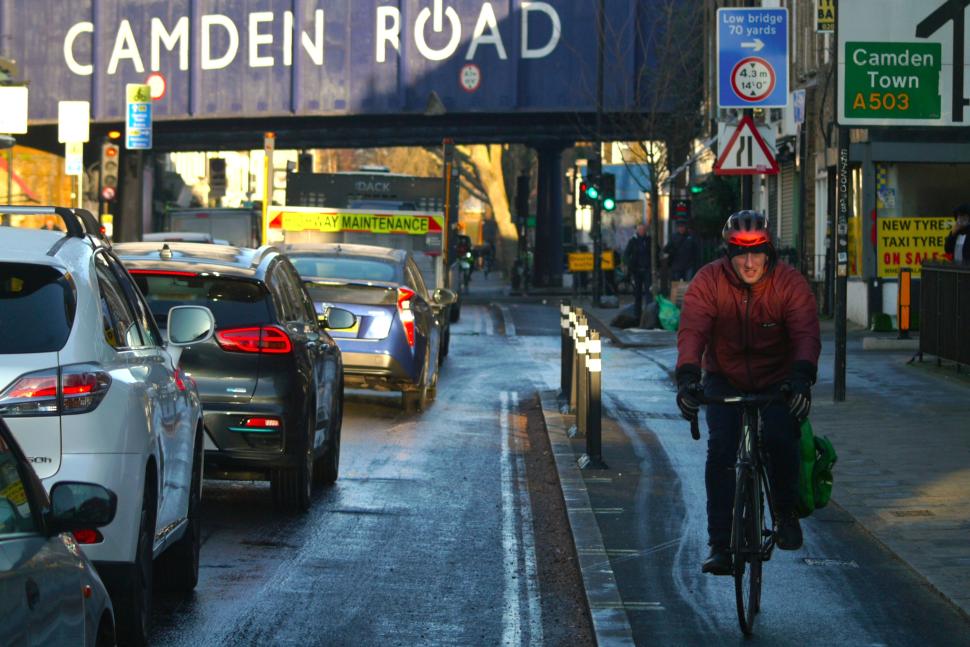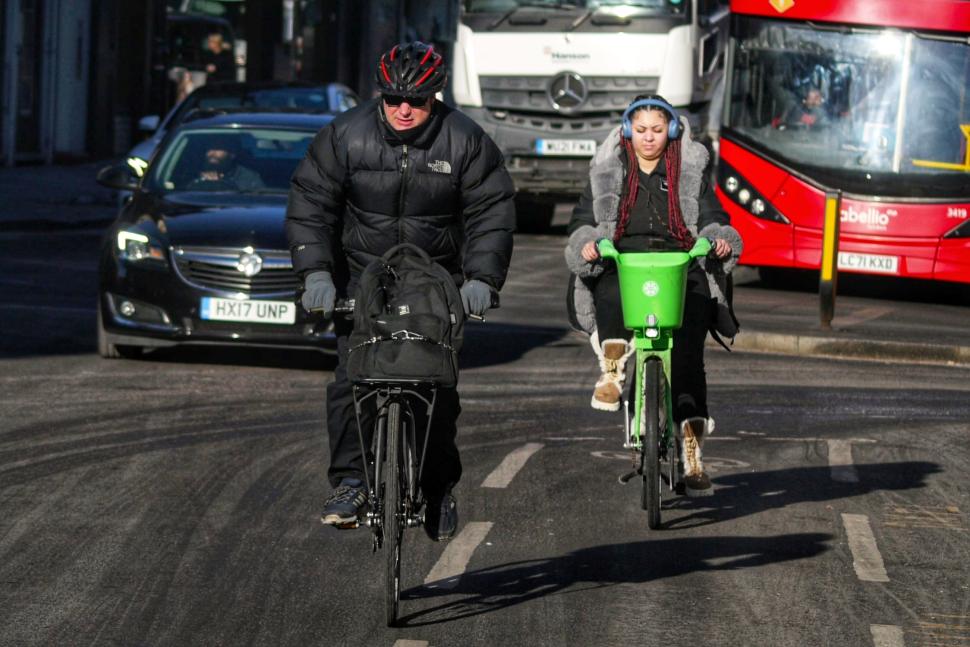New research from University College London supports “the growing evidence that cycling infrastructure helps protect cyclists” and found that riders are more likely to experience dangerous incidents when using routes without bike lanes or cycle paths.
The study, titled ‘Spatiotemporal and behavioural correlates of cycling near misses: evidence from helmet-mounted video data’ and published in Accident Analysis & Prevention, focused on urban riding of cycle commuters in London.
 Cyclists in London Brompton and Lime hire bike (credit: Simon MacMichael)
Cyclists in London Brompton and Lime hire bike (credit: Simon MacMichael)
For a two-week period, 60 cyclists recorded their commutes on 360-degree helmet cameras. This gave researchers 317 hours of footage and 94 ‘near miss events’, defined as where a crash between a cyclist and another road user or pedestrian was narrowly avoided.
During the fortnight none of the 60 London-based participants were involved in a crash, but the 94 near misses gave transport academics at UCL the opportunity to analyse the location, time and nature of incidents with computer modelling and by viewing the camera footage.
Of the 94 incidents, 69 happened on roads without cycling infrastructure. The most common were close passes, followed by drivers right or left-hooking cyclists by turning across their path. Drivers pulling out from side roads or parking spaces was reported as the third most common.
Unsurprisingly, 58 of the incidents happened during the peak commuting hours of 07:00-09:59 in the morning and 17:00-19:59 in the afternoon.
 Cyclist in London Camden cycle lane (credit: Simon MacMichael)
Cyclist in London Camden cycle lane (credit: Simon MacMichael)
Time spent on 30mph roads was linked to higher near miss rates, while time spent on cycleways away from main roads was linked with fewer near misses, as was cycling at higher speeds.
Drivers of cars were the most commonly involved road user, making up 52 of the 94 incidents, while van drivers were involved in 13 and pedestrians in 11 of the incidents. The research noted that no incidents involved heavy goods vehicles.
One of the study’s senior authors, Nicola Christie, said cycling near misses were often “overlooked” in official statistics as they sometimes go unreported. Calling them “crucial indicators of road safety”, the professor explained that the findings “show that most near misses happen on roads without cycling infrastructure, and that junctions are particularly hazardous”.
“One of the benefits of using helmet-mounted cameras and voice-activated reporting as we did in this study is that they offer an easy and effective way to gather data on cycling safety, which can be used to evaluate the impact of infrastructure changes and safety campaigns,” she explained.
“This research adds to the growing evidence that cycling infrastructure helps protect cyclists and that Transport for London’s action plan to improve cycling safety is paying off.”
 Cyclists in London 1 (credit: Simon MacMichael)
Cyclists in London 1 (credit: Simon MacMichael)
Fellow author, Dr James Haworth suggested the findings support the idea that dedicated cycling infrastructure and well-planned routes for cyclists have a “positive impact on road safety”.
“Cycleways navigating through quieter residential streets – formerly called ‘quietways’ – were associated with fewer near misses, despite the fact the rider shares the lane with motor vehicles,” he said. “We believe the reason for this is that these roads often have less traffic, 20mph speed limits and no space to overtake.
“That being said, we did observe near misses on segregated cycle ways – formerly called cycle superhighways in London – where riders and vehicles come into conflict. This was evident where vehicles have to pull out from side roads across the cycle way, for example, or have to turn across oncoming traffic into a side road, particularly in congested periods where visibility is limited.
“So I would say that there is some evidence that using quiet, residential streets for cycle ways is working as a policy because it keeps bicycle traffic away from car traffic.
“There were also some slightly surprising findings in our study, such as faster riders experiencing fewer near misses. One theory that could explain this is that 20mph limits bring the speeds of vehicles and bicycles closer together – but that’s something that would require further investigation.”
 Cyclists in London at traffic lights in cycle lane (credit: Simon MacMichael)
Cyclists in London at traffic lights in cycle lane (credit: Simon MacMichael)
The research was funded by the Road Safety Trust and supported by the Transport for London and the All Party Parliamentary Group on Cycling.
The Road Safety Trust’s chief executive Ruth Purdie OBE said it is important for policymakers to “fully understand” what cyclists experience on the road to inform road improvements and infrastructure projects.
Just last week we reported another similar study which found that physical barriers, such as kerbs and bollards, are most effective in making streets appealing to pedestrians and cyclists.
The study, conducted by experts from the Centre of Transport and Society, based at the University of the West of England, also suggested that bad behaviour is the biggest contributing factor towards streets hostile to walking and wheeling.
In June, a six-year study by academics at the University of New Mexico and University of Colorado Denver concluded that protected cycle lanes encourage significantly more people to cycle than painted routes.

